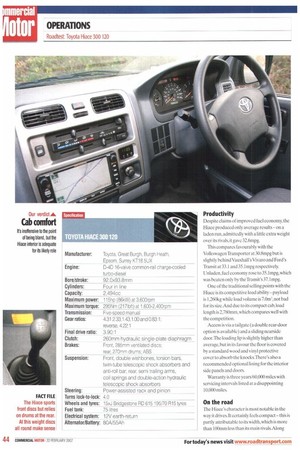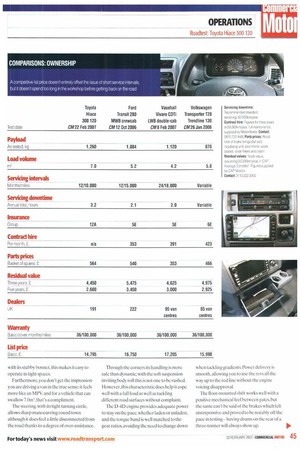Toyota has given its Hiace van a final update before a new model comes along.
Page 43

Page 44

Page 45

Page 46

If you've noticed an error in this article please click here to report it so we can fix it.
But vvill the revamp help it keep up with all those new contenders?
If timing is everything then spare a thought for Toyota's Hiace. A redesign aimed at freshening up the range comes at a time when most of its rivals have launched new models. But then the Hiace has never really followed the pack.
Instead of going head to head with Transit and the boys, it gained a cult following over the years from independent tradesmen and shopkeepers who liked its compact design, manoeuvrability and reputation for reliability.
Having shed its forward-control design in favour of a semi-bonneted style with longitudinally mounted engine back in 1995, the latest version—given a significant revamp in 2001 — receives a modest facelift including new bonnet, headlamps and grille.This doesn't greatly improve the Hiace's appearance; Toyota seems to be sticking to its design watchword: "conservative".
Inside there is new cloth upholstery and the dashboard receives a dash of silver along with a new steering wheel—crazy stuff.
But the majority of the work is hidden away under the bonnet,with the Euro-4 D-4D engine giving more power and improved fuel economy. The 2.5-litre unit has two outputs — 94hp and 115hp, with torque of 230 and 294Nm respectively — and the torque curve has been flattened to improve in-gear acceleration.
Standard equipment has also been boosted: electrically adjustable heated door mirrors, ETA (electronic traffic avoidance) sat-nay and MP3-compatible CD/radio join electric windows and central locking on the spec sheet.
Two accessory packs are available. The Professional includes air-con and rear parking sensors, while the Metallic pack combines.yes, metallic paint with body-coloured bumpers, door handles and full-size wheel covers.
There are two wheelbases with GVWs of 2,800kg (280) and 3,000kg (300).
Prices start at £12,595 for the 94hp 280 version, while our test vehicle, the 115hp 300, comes in at £14,795.
Productivity
Despite claims of improved fuel economy, the Hiace produced only average results— on a laden run, admittedly with a little extra weight over its rivals, it gave 32.6mpg.
This compares favourably with the Volkswagen Transporter at 30.8mpg but is slightly behind Vauxhall's Vivaro and Ford's Transit at 33.1 and 35.1mpg respectively. Unladen, fuel economy rose to 35.1mpg, which was beaten only by the Transit's 37.1mpg.
One of the traditional selling points with the Hiace is its competitive load ability—payload is 1,260kg while load volume is 7.0m3, not bad for its size.And due to its compact cab, load length is 2,780mm, which compares well with the competition.
Access is via a tailgate (a double rear-door option is available) and a sliding nearside door.The loading lip is slightly higher than average, but in its favour the floor is covered by a standard wood and vinyl protective cover to absorb the knocks.There's also a recommended optional lining for the interior side panels and doors.
Warranty is three years/60,000 miles with servicing intervals listed at a disappointing 10,000 miles.
On the road
The Hiace's character is most notable in the way it drives. It certainly feels compact —this is partly attributable to its width, which is more than 100rnm less than its main rivals.Along with its stubby bonnet, this makes it easy to operate in tight spaces.
Furthermore, YOU don't get the impression you are driving a van in the true sense; it feels more like an MPV. and for a vehicle that can swallow 7.0m3, that's a compliment.
The steering, with its tight turning circle, allows sharp manoeuvring round town although it does feel a little disconnected from the road thanks to a degree of over-assistance. Through the corners its handling is more safe than dynamic; with the soft suspension inviting body roll this is not one to be rushed. However, this characteristic does help it cope well with a full load as well.as tackling different road surfaces without complaint.
The D-4D engine provides adequate power to stay on the pace, whether laden or unladen, and the torque band is well matched to the gear ratios, avoiding the need to change down when tackling gradients. Power delivery is smooth, allowing.you to use the revs all the way up to the red line without the engine voicing disapproval.
'the floor-mounted shift works well with a positive mechanical feel between gates, hut the same can't be said of the brakes which felt unresponsive and proved to be notably off the pace in testing— having drums on the rear of a three-tonner will always show up.
Cab comfort
The interior of the Hiace has a distinctly retro feel:think 1990s Japanese saloon, with sliding heating controls and light grey inoffensive plastics.This works to a point; as they hold no surprises, the controls can be navigated without too much trouble. But the Hiace does lack that 'workstation' feel that accompanies many in its class.
Maybe this reflects Toyota's knowledge of its market,because there are many drivers who don't need outright functionality in their day-to-day role but prioritise on fundamentals such as loadspace.
In this case the storage levels are fairly described as adequate, though the door bins are too slim to be deemed useful. But when it comes to those little extra touches, the Hiace disappoint& It also feels a little cramped with three people on board the downside to that reduced width.And its forward-control roots are also evident in the surprisingly thin doors,which inevitably limit the Hiace's side-impact crash protection. •
























































































































































































